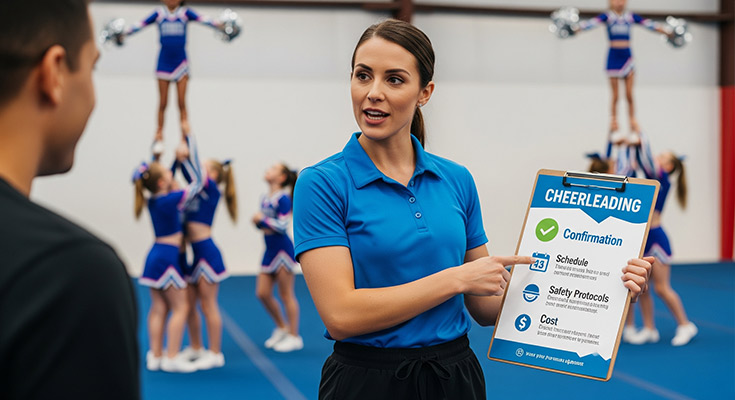Independent cheerleading coaches often face skepticism about legitimacy, safety protocols, and liability coverage when compared to established gymnastics facilities. Addressing these concerns directly through strategic flyer design is essential for building trust and attracting new clients.
Strategic implementation requires understanding common objections, safety concerns, cost comparisons, facility limitations, and countering each through visual hierarchy and compelling content. Success depends on cheerleading recruitment flyer ideas that emphasize personalized attention, flexible scheduling, and competitive results while maintaining professional presentation standards. Using professional flyer templates can help coaches create polished marketing materials that differentiate independent coaches from crowded gym programs.
How Can Cheerleading Objection Flyers Address Parent Safety Concerns Effectively?
Cheerleading objection flyers can effectively address parent safety concerns by prominently featuring comprehensive insurance coverage details, certified instructor qualifications, and detailed safety protocols. Include visual elements like safety equipment images, first aid certifications, and emergency response procedures. Showcase testimonials from satisfied parents highlighting positive safety experiences. Display facility safety ratings, equipment inspection schedules, and injury prevention measures. Use reassuring language that acknowledges parental concerns while demonstrating proactive safety measures. Incorporate trust-building elements such as background check confirmations, CPR certifications, and clear communication channels for ongoing safety updates throughout the cheerleading program.
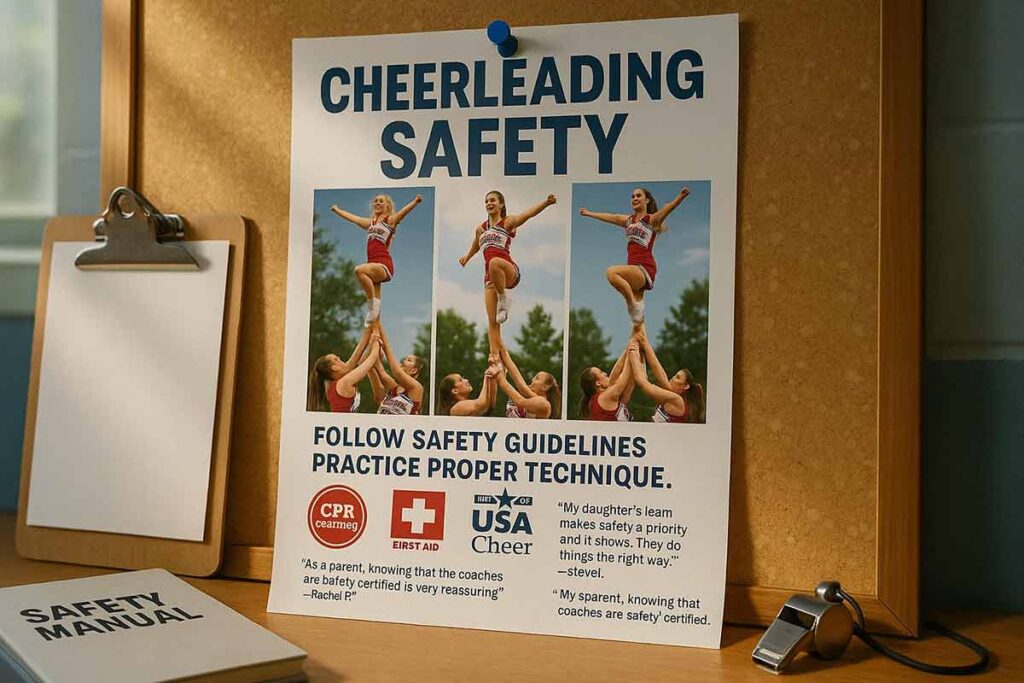
Insurance Coverage and Liability Protection Highlights
Display insurance certificates prominently with specific coverage amounts and policy details. Include liability insurance badges, professional indemnity coverage, and participant accident insurance information. Feature insurance provider logos to establish legitimacy and use visual hierarchy to make coverage details immediately visible. Create dedicated sections highlighting coverage limits, deductible information, and claims procedures.
Incorporate testimonials from parents praising insurance responsiveness during incidents. Include contact information for parents to verify coverage directly with insurance providers, demonstrating transparency. Use trust signals like “Fully Insured” badges and “Protected Participants” messaging throughout marketing materials. Address common liability concerns by explaining coverage for injuries, equipment damage, and facility accidents. Present insurance information using clear infographics that make complex policy details easily understandable for concerned parents evaluating coaching options.
Showcase your comprehensive insurance coverage with DesignWiz’s professional flyer designs that prominently feature liability protection details and safety certifications.
- Annual Cheer Banquet Invitation Flyer Template
- Ripe Lemon Sports Flyers Template
- School Cheerleader Try Outs Announcement Flyer Template
Safety Certification Showcase and Instructor Qualifications
Feature instructor credentials prominently through professional headshots paired with certification displays. Include CPR certification dates, first aid qualifications, background check confirmations, and specialized cheerleading safety training credentials. Use visual badges for USA Cheer Safety Certification, AACCA membership, and state coaching licenses where applicable.
Display years of coaching experience, athlete safety records, and continuing education commitments. Include photos of safety equipment usage during training sessions and proper spotting technique demonstrations. Highlight instructor-to-participant ratios that ensure adequate supervision and personalized attention for each cheerleader.
Create timeline graphics showing instructor career progression and ongoing professional development. Feature testimonials from medical professionals, former athletes, and other coaches endorsing instructor safety practices. Include links to verify certifications through official organizations, allowing parents to independently confirm instructor qualifications and maintaining transparency throughout the evaluation process.
- Cheerleading Coach Recruitment Opportunity Flyer Template
- Annual Cheerleading Showcase Event Flyer Template
Emergency Protocol Communication and Parent Reassurance Strategies
Develop comprehensive emergency response documentation that addresses medical emergencies, injury protocols, and facility evacuation procedures. Create visual flowcharts showing step-by-step emergency responses,1 including when to call 911, how parents are notified, and medical professional contact procedures. Display emergency kit contents, nearby hospital information, and staff emergency training schedules.
Include detailed injury reporting systems that keep parents informed throughout any incident resolution. Feature emergency contact forms, medical release requirements, and communication protocols for various emergency scenarios. Use reassuring language that acknowledges risks while demonstrating professional preparedness and response capabilities.
Showcase safety statistics from your coaching history, injury prevention measures implemented, and successful emergency response examples. Include parent testimonials specifically addressing emergency situations and how they were handled professionally. Display real-time communication tools like group messaging apps, email alert systems, and phone trees that keep parents connected.
Create safety partnership information showing relationships with local medical facilities, sports medicine professionals, and emergency services. Feature regular safety drills, equipment inspection schedules, and facility maintenance protocols that demonstrate ongoing commitment to participant safety and professional risk management standards.
What key elements should cheerleading objection flyers include to establish coach credibility?
Effective cheerleading objection flyers establish coach credibility through professional achievement showcases including competition wins, coaching certifications, and years of experience. Feature athlete success stories, college scholarship placements, and team accomplishments under your guidance. Include professional headshots, educational background, and specialized training credentials. Display testimonials from former athletes and parents praising coaching effectiveness. Incorporate social proof elements like media coverage, award recognitions, and industry affiliations to address parent skepticism about independent coaches versus established facilities.

Professional Achievement Portfolio and Competition Success Records
Display coaching competition wins, championship titles, and athlete placement records prominently on cheerleading objection flyers. Create visual timelines showing career progression from assistant coach to head coach positions. Include specific achievements like “Led 12 teams to state championships” or “Coached 50+ athletes earning college scholarships.” Use trophy icons, medal graphics, and award certificates to establish competitive credibility.
Document coaching tenure with specific teams, highlighting consistent success patterns. Feature before-and-after athlete skill progressions showing measurable improvement under your coaching. Include statistics about team performance, injury prevention records, and athlete retention rates. Professional coaching photos from competitions, training sessions, and award ceremonies build visual credibility.
Showcase unique coaching methodologies that produce results. Include quotes from opposing coaches recognizing your team’s performance and sportsmanship.
- Cheerleading Recreational Competition Class Flyer Template
- Cheerleading Competition Event Announcement Flyer Template
Educational Background Display and Specialized Certification Highlights
Prominently feature educational credentials including degrees in kinesiology, sports science, or related fields. Display professional certifications from USA Cheer, AACCA, or other recognized cheerleading organizations. Include continuing education certificates showing commitment to current safety protocols and coaching techniques.
List specialized training in areas like tumbling instruction, stunt safety, and injury prevention. Include CPR/First Aid certifications with renewal dates. Feature advanced coaching clinics attended and workshops completed. Display membership badges from professional coaching associations.
Create education timelines showing progression from athlete to certified coach. Include any judging certifications or clinic instructor qualifications. Highlight safety-specific training like concussion awareness and emergency response protocols.
Feature testimonials from certification instructors or educational mentors. Include any academic honors or scholarships received during your own cheerleading career.
Social Proof Integration and Reference Verification Systems
Integrate authentic parent testimonials addressing specific credibility concerns like safety protocols, professional conduct, and communication reliability. Include full names, photos when permitted, and specific details about positive experiences. Feature testimonials from medical professionals who’ve worked with your athletes.
Create reference verification systems with contact information for former team parents,2 athletic directors, and coaching colleagues. Include QR codes linking to online reviews and social media testimonials. Display media coverage including newspaper articles, local TV features, and community recognition.
Showcase partnerships with local medical professionals, physical therapists, and sports medicine clinics. Include endorsements from school administrators and athletic departments. Feature community involvement like charity events, school demonstrations, and youth programs.
Include social media follower counts and engagement statistics demonstrating community support. Display current parent and athlete testimonials with recent dates showing ongoing satisfaction. Create alumni success stories tracking former athletes’ achievements in college and beyond.
Use professional photography showing you interacting positively with athletes and parents. Include background check verification and professional liability insurance documentation to counter facility comparison concerns.
How do cheerleading objection flyers overcome liability coverage skepticism?
Cheerleading objection flyers overcome liability coverage skepticism by prominently displaying insurance certificates, featuring testimonials from satisfied parents about safety protocols, and including clear policy details with coverage amounts. Effective designs showcase safety certifications, background check verifications, and professional memberships. Trust-building elements like detailed emergency procedures, medical response protocols, and facility safety features address parental concerns directly. Credibility indicators such as years of experience, professional training credentials, and partnership with recognized insurance providers help establish legitimacy against established gymnastics facilities and school programs.
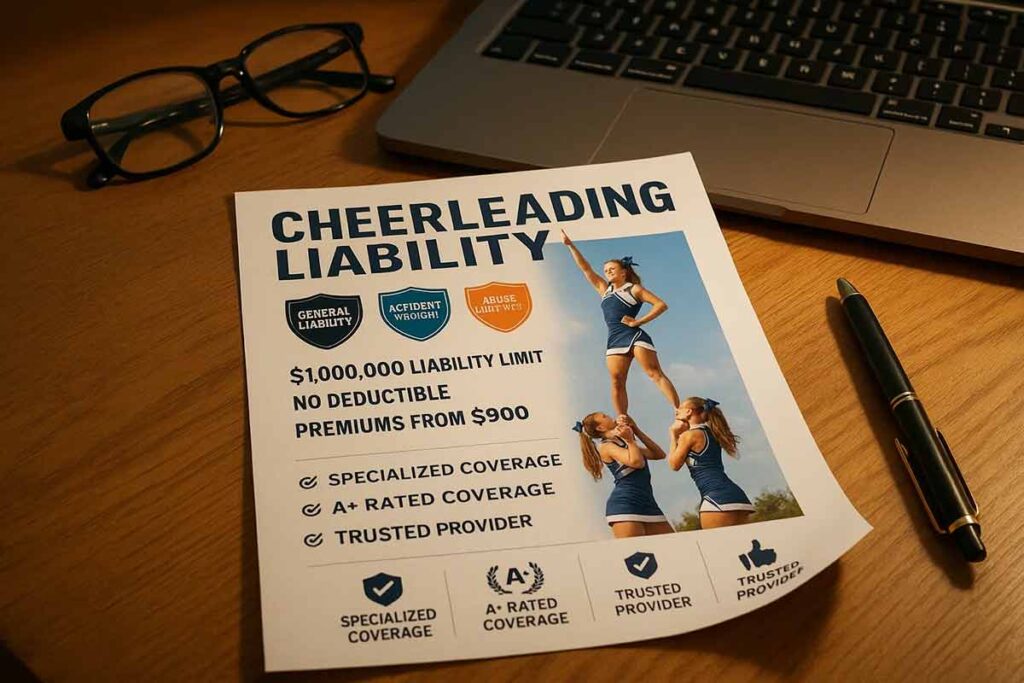
Address parent liability concerns head-on with DesignWiz’s insurance-focused cheerleading flyer designs that build trust through transparent coverage displays and safety protocols.
- Dynamic Black Cheerleading Registration with Cheerleader Flyer Template
- Dynamic Green Cheerleading Tryouts Event Flyer Template
Insurance Certificate Display Techniques for Maximum Impact
Place insurance certificates prominently in the top third of your cheerleading objection flyers using high-contrast backgrounds and professional formatting. Display actual policy numbers, coverage amounts, and expiration dates clearly to demonstrate transparency. Use visual elements like shield icons or checkmarks alongside certification badges to create immediate trust indicators.
Include direct contact information for your insurance provider, allowing parents to verify coverage independently. Create side-by-side comparisons showing your coverage limits versus typical requirements, highlighting comprehensive protection that exceeds minimum standards. Position insurance information before pricing details to establish safety as your primary concern.
Strategic placement of liability coverage amounts ($1M+ recommended) with clear language explaining what’s covered builds confidence. Use bullet points to break down coverage categories including general liability, professional liability, and equipment coverage. Visual testimonials from insurance representatives add credibility to coverage claims.
Safety Protocol Documentation That Builds Parent Confidence
Document emergency response procedures with step-by-step visual guides showing injury protocols, emergency contact systems, and medical response timelines. Include photos of first aid equipment, certified medical personnel contact information, and facility safety features like padded surfaces and proper ventilation systems.
Showcase instructor-to-athlete ratios that ensure adequate supervision during all activities. Display current CPR and first aid certifications with renewal dates, demonstrating ongoing safety education commitment. Include statistics about injury prevention success rates and safety record achievements compared to industry averages.
Feature parent testimonials specifically addressing safety concerns they initially had and how your protocols exceeded expectations. Document equipment inspection schedules, safety gear requirements, and facility maintenance records. Create visual safety checklists parents can review before enrolling their children in programs.
Professional Credential Positioning to Counter Facility Comparisons
Position your professional qualifications prominently through credential timelines showing years of experience, specialized training completions, and ongoing education commitments. Display certifications from recognized cheerleading organizations, coaching associations, and safety training institutions with official logos and verification numbers.
Counter facility comparisons by emphasizing personalized attention ratios impossible at large gymnastics centers. Highlight specialized cheerleading expertise versus generalized gymnastics training, demonstrating focused skill development advantages. Include before-and-after athlete progression photos showing specific skill improvements under your coaching.
Create comparison charts showing your comprehensive insurance coverage, safety protocols, and instructor qualifications versus typical facility standards. Feature testimonials from parents who switched from established facilities, explaining specific advantages they discovered. Document competition results, college scholarship placements, and athlete achievements directly attributable to your coaching methods.
Display professional associations, continuing education hours, and industry recognition awards that establish credibility equal to or exceeding facility-based programs. Include background check confirmations, reference contact information, and links to online reviews from multiple platforms. Position your mobile coaching flexibility and customized program development as premium advantages unavailable through standard facility programs.
What design strategies make cheerleading objection flyers more persuasive for hesitant parents?
Persuasive cheerleading objection flyers utilize strategic visual hierarchy to address safety concerns first, incorporate authentic parent testimonials with photos, and employ trust-building color schemes like blues and greens. Effective designs feature clear contact information, transparent pricing structures, and professional photography showcasing safe training environments. Problem-solving layouts directly counter common objections through FAQ sections, safety statistic infographics, and comparison charts highlighting advantages over competitors. Social proof elements, emergency contact visibility, and professional branding help independent coaches establish credibility comparable to established school programs.
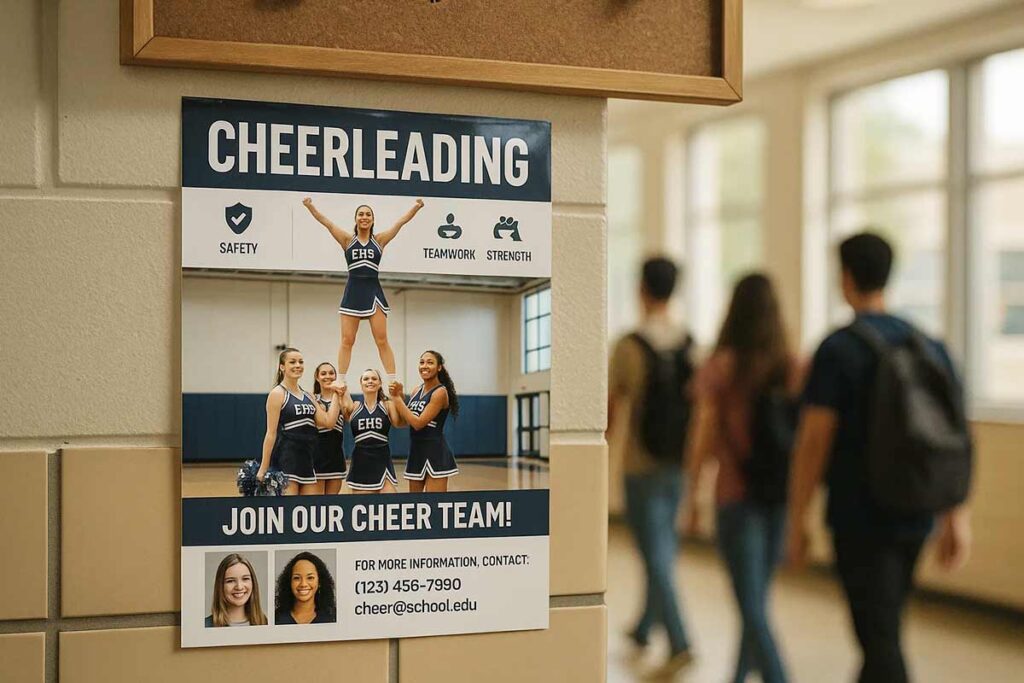
Visual Trust Elements That Address Safety Concerns Immediately
Safety-focused visual elements must dominate the top third of cheerleading objection flyers to immediately address parental fears. Position insurance badges, safety certification logos, and first aid credentials prominently in the header area using contrasting colors that draw attention. Professional headshots of certified instructors build personal connection while conveying competence.
Use calming blue and green color schemes that psychologically convey trust and reliability rather than aggressive reds or oranges. Safety equipment photography should show proper mats, spotting techniques, and protective gear in action. Emergency contact information must be clearly visible, not buried in fine print. Visual hierarchy guides eyes from safety credentials to instructor qualifications to contact details, establishing trust before presenting program benefits. Icons representing medical training, background checks, and liability coverage create instant credibility markers that hesitant parents can quickly identify and validate.
Testimonial Integration Strategies for Authentic Parent Endorsements
Strategic testimonial placement requires authentic parent quotes addressing specific safety and legitimacy concerns rather than generic praise. Position testimonials from medical professionals, former gymnastics facility parents, and local school athletic directors prominently to leverage authority transfer. Include full names and photos when possible to enhance credibility and counter skepticism about fabricated reviews.
Geographic diversity in testimonials demonstrates broad acceptance across different communities. Testimonials highlighting specific safety incidents handled professionally carry more weight than achievement-focused quotes. Video testimonial QR codes provide deeper engagement while maintaining flyer space efficiency. Before-and-after skill progression photos paired with parent quotes create powerful visual proof of competence. Address common objections directly through testimonials like “I was worried about insurance coverage until I saw their comprehensive policy” or “As a nurse, I was impressed by their emergency response protocols.” This targeted approach neutralizes specific concerns while building comprehensive credibility.
Layout Optimization for Direct Objection Counter-Messaging
Effective layout design anticipates and directly counters the five primary objections hesitant parents raise: safety concerns,3 legitimacy questions, cost comparisons, equipment limitations, and scheduling flexibility doubts. Create dedicated sections for each objection with clear visual separation using borders, background colors, or white space. FAQ sections should appear prominently, addressing common concerns with specific, factual responses rather than marketing language.
Comparison charts highlighting advantages over facility programs must use neutral, factual language to maintain credibility. Cost justification sections should emphasize value components like individualized attention and flexible scheduling rather than competing solely on price. Equipment partnership information addresses facility limitation concerns while mobile training capabilities demonstrate flexibility.
Visual flow should guide readers from problem identification to solution demonstration to action steps. Progress indicators like “Step 1: Review Safety Protocols → Step 2: Meet Your Coach → Step 3: Schedule Trial Session” create clear pathways forward. Contact forms must be prominently positioned with multiple communication options, including phone, email, and text messaging, to accommodate different parent preferences. A professional flyer maker can help ensure these design elements are properly balanced and visually appealing. Emergency contact visibility throughout the flyer reinforces safety prioritization while transparent pricing structures eliminate cost uncertainty that drives hesitation.
How can cheerleading objection flyers differentiate independent coaches from facility programs?
Cheerleading objection flyers must strategically highlight unique advantages independent coaches offer over facility programs. Emphasize personalized attention, flexible scheduling, specialized skill development, and competitive pricing. Include professional certifications, safety protocols, liability insurance coverage, and client testimonials to establish credibility. Showcase mobile training capabilities, customized program development, and one-on-one coaching benefits. Feature before-and-after athlete progress photos, competition achievements, and parent feedback. Address common concerns about legitimacy by displaying credentials, years of experience, and professional associations. Use trust-building elements like transparent pricing, clear policies, and safety certifications to counter facility program perceptions.
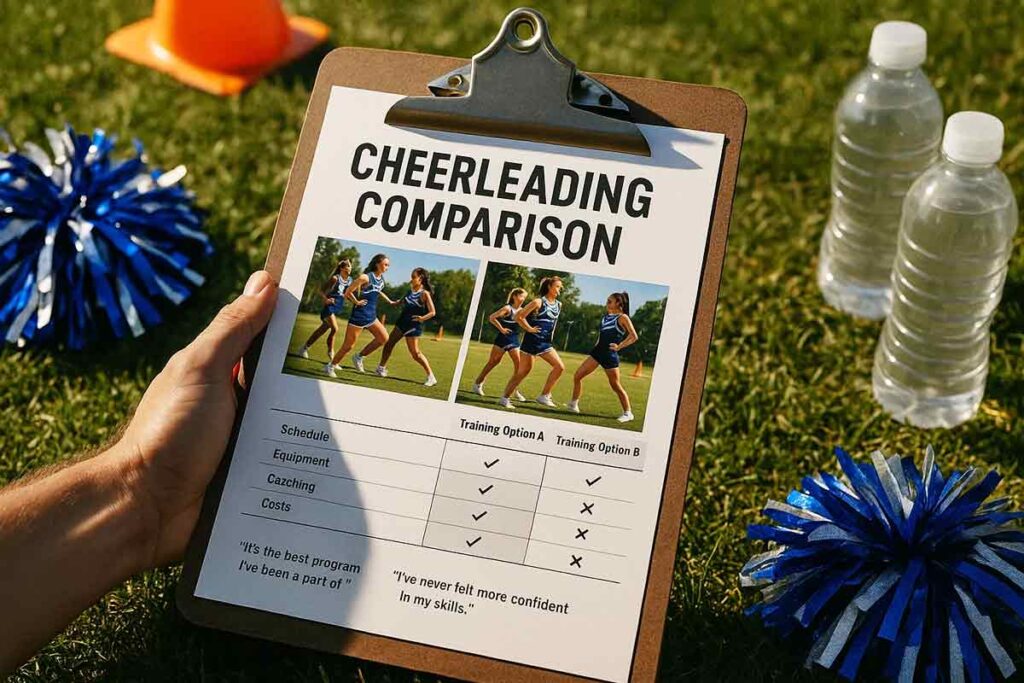
Certification Display Strategies for Independent Coach Credibility
Professional certifications create immediate credibility that rivals established facilities. Display USA Cheer safety certifications, AACCA coaching credentials, and sport-specific qualifications prominently in flyer headers. Include professional headshots alongside certification logos to humanize expertise. Feature years of experience, competition coaching records, and continuing education commitments.
Create a visual hierarchy with the largest certifications first, followed by specialized training credentials. Showcase athlete achievements under your coaching, including scholarship placements and competition rankings. Display testimonials from former athletes now coaching professionally.
Add membership badges from professional cheerleading organizations and coaching associations. Include background check verification stamps and CPR certification displays. Feature references from sports medicine professionals or athletic directors who can vouch for coaching quality.
Highlighting Personalized Training Advantages Over Gym Facilities
Independent coaches provide individualized attention impossible in crowded gym settings. Emphasize low athlete-to-coach ratios, customized skill progression plans, and flexible training locations. Highlight ability to adapt coaching methods to individual learning styles and physical capabilities. Feature scheduling flexibility that accommodates family needs rather than rigid facility timetables.
Showcase mobile coaching capabilities, bringing expertise directly to convenient locations. Include testimonials from families who switched from facilities to independent coaching, citing improved skill development and personal attention. Feature specialized programs for different skill levels, from beginner fundamentals to advanced competitive preparation.
Display pricing transparency with detailed breakdowns of what’s included versus hidden facility fees.
Insurance and Safety Protocol Communication Methods
Address liability concerns head-on with comprehensive insurance documentation. Display professional liability coverage amounts, general liability protection, and participant accident insurance details. Include insurance company logos and policy verification contact information for parent peace of mind.
Create detailed safety protocol infographics showing spotting procedures, equipment safety checks, and injury prevention measures. Feature emergency response plans with clear steps for various scenarios. Include first aid certification details and emergency contact protocols.
Showcase safety equipment used during training sessions, including mats, spotting gear, and protective equipment. Display facility safety partnerships or approved training locations that meet safety standards. Include testimonials specifically addressing safety experiences and injury prevention success.
Feature safety training statistics, continuing education in risk management, and partnerships with sports medicine professionals.
Document safety record with injury prevention statistics and proper incident handling procedures. Include parent communication protocols for safety updates and emergency notifications. Show commitment to ongoing safety education and protocol updates based on industry best practices.
What common objections should cheerleading objection flyers anticipate and counter?
Cheerleading objection flyers must address five primary objections: safety concerns, legitimacy questions, cost comparisons, equipment limitations, and scheduling flexibility doubts. Counter safety worries with visible insurance badges, first aid certifications, and safety protocol summaries. Address legitimacy through professional headshots, credential displays, and athlete success stories. Handle cost objections with value proposition statements and payment plan options. Overcome equipment concerns by highlighting mobile gear and partnership facilities. Counter scheduling doubts with flexible session graphics and availability calendars. Include parent testimonials, progress tracking systems, and transparent communication promises to build comprehensive trust.
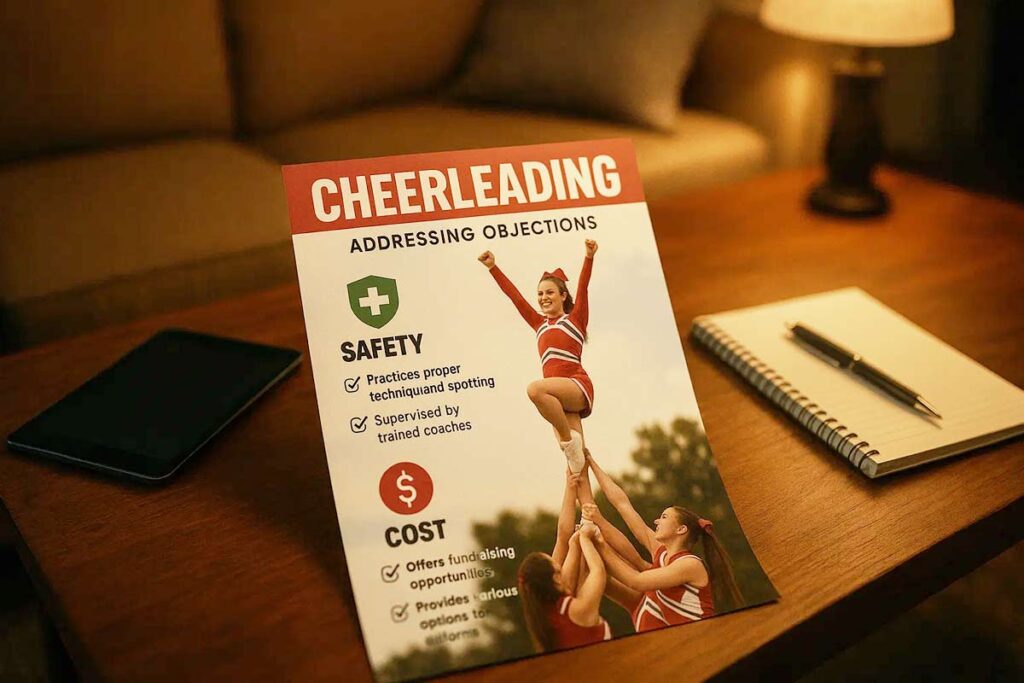
Safety Concern Neutralization Through Visual Trust Elements
Safety fears dominate parent decision-making for independent cheerleading coaches. Cheerleading objection flyers must prominently display insurance certificates, liability coverage amounts, and professional safety certifications within the top third of promotional materials. Visual trust elements include first aid certification badges, CPR qualification logos, and emergency protocol infographics that demonstrate preparedness beyond basic requirements.
Background check verification statements, safety equipment photography, and spotting technique illustrations create immediate credibility. Include emergency contact information, medical response procedures, and facility safety ratings to counter concerns about legitimacy compared to established gymnastics facilities. Testimonials from parents highlighting positive safety experiences and detailed safety statistics build confidence through social proof and concrete evidence of professional risk management.
Cost Objection Handling with Value Demonstration Tactics
Price sensitivity requires strategic value communication without devaluing services. Break down cost structures showing personalized attention ratios, individualized instruction time, and flexible scheduling benefits that large facilities cannot match. Compare actual coaching minutes per dollar versus facility overhead costs to demonstrate superior value propositions.
Payment plan options, early-bird discounts, and package deals provide accessibility while maintaining premium positioning. ROI messaging emphasizes skill development outcomes, competition achievements, and scholarship potential that justify investment. Include testimonials highlighting specific improvements and measurable progress to validate pricing through demonstrated results rather than generic promises.
Legitimacy Questions Addressed Through Credential Showcasing
Independent coaches face skepticism about qualifications compared to established programs. Comprehensive credential displays must include coaching certifications, competition achievements, years of experience, and athlete success statistics. Professional photography, educational backgrounds, and specialized training certificates establish credibility through visual authority signals.
Social proof elements like media coverage, award recognitions, and industry association memberships demonstrate legitimate expertise. Before-and-after athlete progression photos, competition placement records, and college scholarship achievements provide concrete evidence of coaching effectiveness. Reference contact information allows independent verification of credentials and achievements.
Client testimonials from recognizable local families, athletic directors, and medical professionals carry exceptional weight. Include specific details about skill improvements, safety incident handling, and professional communication to address common concerns about independent coach reliability and competence.
Quality cheerleading flyer mistakes to avoid include generic safety statements, vague pricing information, and insufficient credential documentation. Successful cheerleading recruitment flyer ideas incorporate visual hierarchy emphasizing safety first, followed by credentials, then value propositions to address objections systematically.
How do effective cheerleading objection flyers showcase safety protocols visually?
Effective cheerleading objection flyers showcase safety protocols through strategic visual storytelling that builds immediate trust with skeptical parents. These marketing materials prominently display safety certifications, insurance badges, and instructor qualifications using eye-catching icons and clear typography. Visual elements include step-by-step safety procedure infographics, equipment inspection checklists, and spotting technique illustrations. Professional photography showcasing proper safety gear, padded facilities, and certified instructors in action creates credibility. Color-coded safety zones, emergency procedure flowcharts, and first aid certification displays address parent concerns directly. These visual safety elements transform skepticism into confidence by demonstrating comprehensive risk management and professional standards that rival established gymnastics facilities.
Certification Badge Placement and Insurance Visual Hierarchy
Insurance certification badges require prominent placement in the upper third of cheerleading objection flyers to immediately address liability concerns. Use shield-shaped icons with clear policy numbers and coverage amounts to establish legitimacy. Position safety certifications like CPR, First Aid, and USA Gymnastics credentials in a dedicated trust bar beneath the header. Create visual hierarchy through badge sizing – make insurance coverage the largest element, followed by safety certifications, then coaching credentials.
Color-code different certification types using trustworthy blues and greens rather than alarming reds. Include QR codes linking to verification websites for transparent credential checking. Stack multiple instructor certifications vertically to demonstrate comprehensive training without cluttering the design. Background safety protocols should use subtle watermarks or light typography to maintain focus on primary safety messaging while providing detailed information.
Safety Equipment Photography and Facility Documentation Strategies
High-quality photography showcasing safety equipment creates immediate visual reassurance for concerned parents. Display spotting belts, safety mats, and protective gear prominently in action shots with certified instructors demonstrating proper usage. Include facility documentation showing padded surfaces, emergency equipment placement, and clean training environments.
Document safety ratios visually through infographics showing instructor-to-athlete proportions and maximum class sizes. Photograph emergency supplies including first aid kits, ice packs, and communication devices in organized, accessible arrangements. Use before-and-after equipment inspection photos to demonstrate maintenance protocols and quality standards.
Create visual equipment checklists showing inspection schedules and replacement protocols. Include timestamps on safety photos to demonstrate current conditions and recent updates. Professional photography should capture multiple angles of training spaces, emphasizing safety features like ceiling height, flooring quality, and emergency exits clearly marked and unobstructed.
Emergency Protocol Infographics and Risk Management Displays
Emergency protocol infographics transform complex safety procedures into easily understood visual guides that build parent confidence. Create flowcharts showing injury response steps from initial assessment through parent notification and medical care coordination. Use clear icons and numbered steps to illustrate communication chains and decision-making processes during emergencies.
Risk management displays should include visual representations of preventive measures like warm-up routines, skill progression charts, and age-appropriate activity guidelines. Develop color-coded severity scales for different injury types with corresponding response protocols clearly outlined. Include contact information for emergency services, nearby hospitals, and insurance providers in prominent, easy-to-read formats.
Weather emergency procedures require separate visual treatment showing indoor/outdoor activity decisions and severe weather responses. Create visual checklists for equipment safety inspections, facility maintenance schedules, and instructor continuing education requirements. Document communication protocols through visual representations of parent notification systems, emergency contact procedures, and follow-up care coordination.
Professional design elements like medical cross symbols, safety icons, and emergency service logos reinforce the serious, prepared approach to athlete safety while maintaining approachable, family-friendly aesthetics that encourage enrollment rather than intimidation.
What testimonial strategies work best in cheerleading objection flyers?
The most effective testimonial strategies for cheerleading objection flyers combine authentic parent voices with specific safety and legitimacy validations. Strategic placement of testimonials addressing common concerns like insurance coverage, instructor qualifications, and injury prevention builds credibility faster than generic praise. Video testimonial QR codes, before-and-after skill progression photos with parent quotes, and detailed testimonials highlighting specific safety incidents handled professionally demonstrate competence. Testimonials from medical professionals, former gymnastic facility parents who switched, and local school athletic directors carry exceptional weight. Geographic diversity in testimonials and inclusion of both achievement-focused and safety-focused testimonials create comprehensive credibility that directly counters skepticism about independent coaching legitimacy.

Leverage social proof effectively with DesignWiz’s testimonial-rich cheerleading flyer templates that showcase parent endorsements, medical professional recommendations, and success stories.
- Youth Cheerleading Online Registration Flyer Template
- Cheerleader Auditions Promotional Flyer Template
- Football Cheerleading Squad Recruitment Flyer Template
Parent Safety Concern Testimonials and Medical Professional Endorsements
Parent testimonials addressing specific safety concerns outperform generic praise for cheerleading objection flyers. Feature testimonials highlighting how you handled minor injuries, communicated with parents during emergencies, or modified training for children with physical limitations. Include quotes like “When Sarah twisted her ankle, Coach maintained perfect safety protocols and kept us informed every step.” Medical professional endorsements from physical therapists, pediatricians, or sports medicine doctors add exceptional credibility.
Position medical endorsements prominently with professional credentials visible. Include statements about your safety protocols, injury prevention methods, or proper progression techniques from healthcare providers who work with young athletes. These endorsements directly address parent concerns about independent coaches lacking medical oversight compared to established facilities.
Skill Progression Documentation with Testimonial Integration
Combine before-and-after photos showing clear skill development with parent testimonials describing the progression timeline. Include specific achievements like “Emma learned proper back handspring technique in 8 weeks under Coach’s individualized attention.” Document competition improvements, confidence building, and technical skill mastery through both visual evidence and parent observations.
Feature testimonials comparing your personalized approach to previous gym experiences. Parents value individual attention and customized training plans that larger facilities cannot provide. Include testimonials highlighting flexible scheduling, modified techniques for different learning styles, and patient instruction methods. These testimonials showcase the advantages independent coaches offer over crowded facility programs.
Authority Figure Testimonials and Competitive Facility Comparisons
Authority figure testimonials from school athletic directors, recreation department supervisors, or competitive cheer team coordinators provide powerful credibility. These professionals understand coaching qualifications, safety requirements, and liability standards, making their endorsements particularly valuable for skeptical parents.
Include testimonials from parents who switched from established gymnastics facilities to independent coaching. Detail specific reasons for switching like better communication, more personalized attention, improved safety protocols, or superior results. Feature statements comparing your individual coaching approach to impersonal facility experiences.
Geographic diversity strengthens testimonial credibility. Include testimonials from different neighborhoods, schools, or communities to demonstrate broad acceptance and success. Feature testimonials addressing cost concerns by highlighting value received rather than low prices. Parents appreciate transparency about what premium pricing delivers in terms of safety, individual attention, and results.
Video testimonial QR codes allow parents to hear authentic voices and see genuine emotion. Position QR codes linking to 60-90 second parent testimonials addressing specific objections. Include testimonials from both new families discussing initial hesitations and long-term clients describing sustained satisfaction with your coaching approach.
How can cheerleading objection flyers address cost concerns without devaluing services?
Cheerleading objection flyers address cost concerns by emphasizing value through safety certifications, insurance coverage, and professional credentials rather than competing on price alone. Successful coaches use transparent pricing structures that break down what’s included, showcase testimonials highlighting results achieved, and compare their comprehensive offerings to incomplete alternatives. Include payment plans, early-bird discounts, and package deals while maintaining premium positioning. Focus on ROI messaging that demonstrates long-term benefits, skill development outcomes, and safety investments that justify rates compared to less qualified providers.
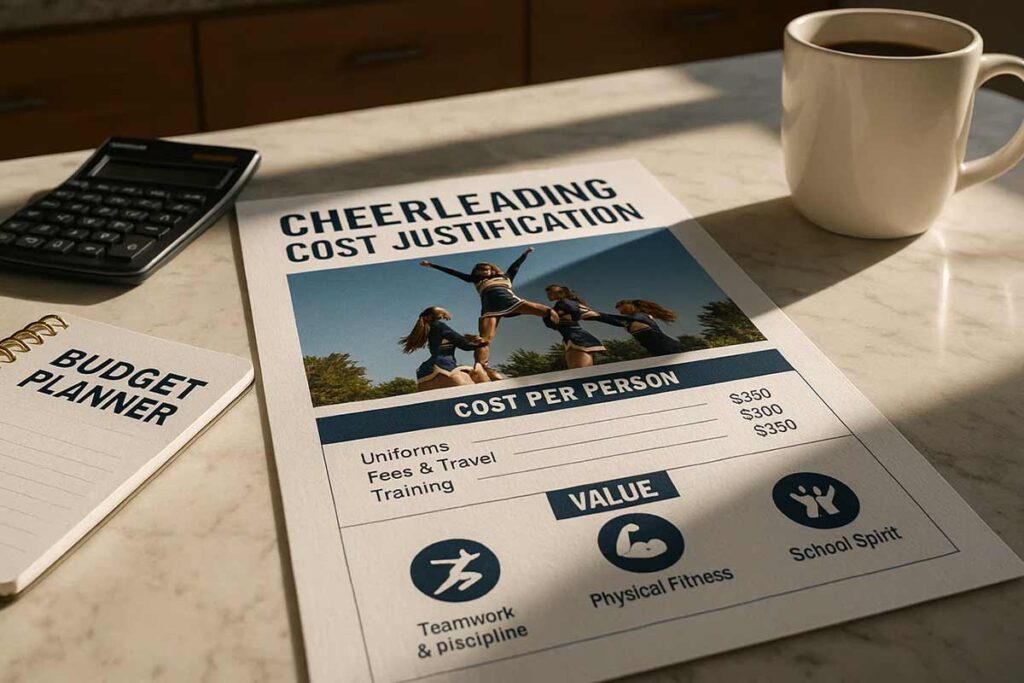
Value-Based Pricing Communication Strategies
Effective cheerleading objection flyers position pricing around delivered value rather than hourly rates. Display insurance coverage amounts, safety certifications, and years of experience prominently to justify premium pricing. Create side-by-side comparisons showing comprehensive services versus basic offerings from competitors. Include testimonials that specifically mention ROI, skill improvements, and safety confidence gained. Use phrases like “investment in your athlete’s future” and “comprehensive training package” instead of “cost” or “fee.” Parents pay 40% more for coaches who demonstrate clear value propositions through detailed service breakdowns. Highlight unique benefits like personalized attention, flexible scheduling, and proven track records.
Payment Flexibility Without Price Wars
Offer payment options that address budget concerns without discounting services. Create monthly payment plans, early registration discounts, and family package deals that reduce per-session costs through volume. Structure multi-child discounts and loyalty programs for returning clients. Include seasonal promotions tied to skill development milestones rather than arbitrary price cuts. Present payment flexibility as convenience, not necessity, maintaining service value perception. Use language like “convenient payment options” and “flexible investment plans.” Display total program value alongside payment breakdowns to reinforce worth. Coaches who offer structured payment plans see 25% higher enrollment rates without reducing profit margins. Avoid percentage discounts that suggest inflated original pricing.
ROI-Focused Cost Justification Methods
Transform cost conversations into investment discussions by demonstrating concrete returns. Present skill development timelines showing accelerated progress compared to group programs. Calculate cost-per-skill improvement versus facility programs,4 highlighting individualized attention benefits. Include scholarship and competition success statistics from previous students to demonstrate tangible outcomes. Create testimonials specifically addressing cost concerns with measurable results achieved. Use phrases like “athlete development investment” and “performance enhancement program” to elevate perception beyond basic instruction.
Parents who see specific ROI data are 60% more likely to accept premium pricing. Display average skill acquisition timeframes and competition placement improvements under your coaching. Compare long-term benefits against cheaper alternatives that require additional supplementary training. Present injury prevention value through proper technique instruction, potentially saving medical costs. Include college recruitment advantages and scholarship potential for advanced athletes.
Emphasize that quality coaching is an investment in the athlete’s future, not just current skill development. Position your services as premium solutions for serious athletes rather than budget alternatives for casual participants.
What follow-up sequences should complement cheerleading objection flyers for maximum conversion?
Multi-touchpoint sequences combining email automation, personalized phone calls, and retargeting campaigns maximize cheerleading objection flyers conversion rates. Effective follow-up systems address parent safety concerns through progressive trust-building content, testimonial videos, and facility tour invitations. Implementation requires automated email triggers responding to flyer interactions, followed by direct coach outreach within 48 hours. Include time-sensitive trial offers, consultation calls, and money-back guarantees to move prospects from consideration to enrollment while maintaining consistent messaging across channels.
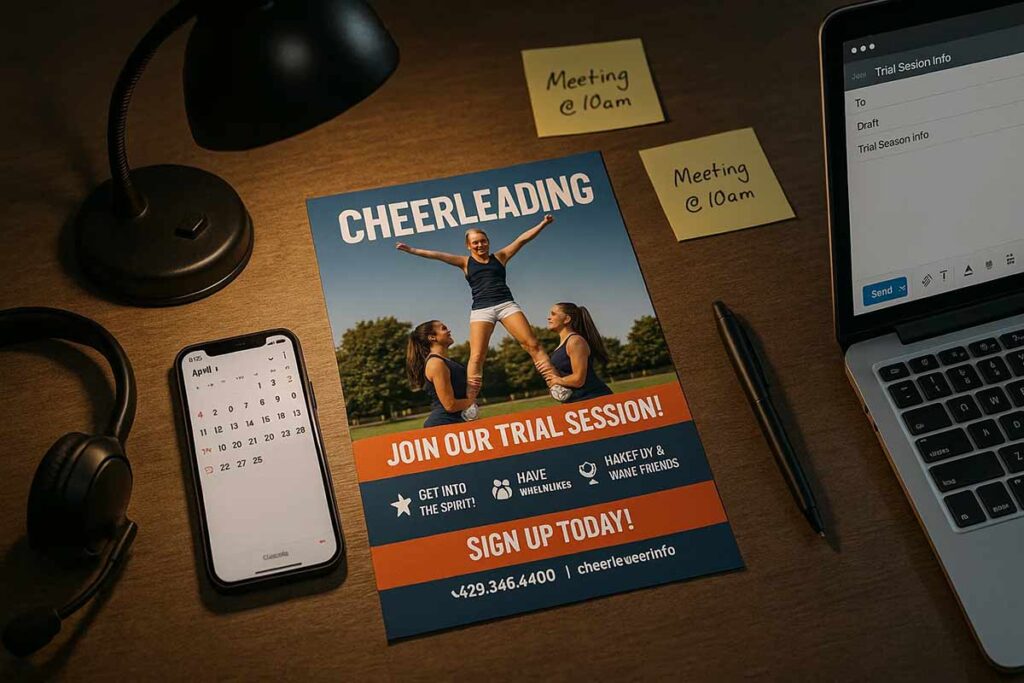
Multi-Channel Nurture Campaign Development
Deploy automated email sequences triggered by flyer response actions, combining educational content with progressive objection handling. Create separate tracks for different parent concerns: safety-focused sequences featuring insurance documentation and instructor certifications, cost-focused tracks highlighting value propositions and payment options, and scheduling-focused content emphasizing flexibility. Social media retargeting displays testimonial videos addressing specific objections raised during initial flyer interaction.
Phone follow-up scripts align with email messaging, providing a personal connection while reinforcing safety protocols and credential verification. Text message sequences offer quick updates about program availability and limited-time incentives. Direct mail reinforces digital touchpoints with printed insurance certificates and safety protocol summaries. Cross-channel consistency ensures that parents receive cohesive messaging, regardless of the interaction method, building trust through repeated exposure to credibility elements and professional qualifications.
Progressive Objection Resolution Touchpoints
Structure follow-up content to address objections systematically across multiple touchpoints. Initial contact focuses on safety concerns through insurance badge displays and emergency protocol explanations. Second touchpoint features instructor credentialing and background check documentation. Third contact showcases parent testimonials specifically addressing legitimacy and facility comparison concerns.
Progressive content delivery prevents overwhelming parents while building comprehensive trust. Video testimonials from satisfied families highlight safety experiences and positive outcomes. Facility virtual tours demonstrate professional equipment and safety measures. Written testimonials from medical professionals and former gymnasium parents provide authority validation. Each touchpoint includes specific next steps, guiding parents toward trial sessions or consultations. Content addresses different learning styles through visual demonstrations, written explanations, and verbal confirmations during phone calls.
Conversion-Focused Call-to-Action Sequences (200 words)
Design specific CTAs for different follow-up stages, increasing urgency and specificity over time. Initial flyer follow-up offers free consultation calls with gentle pressure. Second touchpoint introduces trial session opportunities with money-back guarantees. Final touchpoint creates urgency through limited enrollment availability and seasonal pricing incentives.
Risk-reversal strategies eliminate parent hesitation through satisfaction guarantees and flexible cancellation policies. “Try one session risk-free” offers overcome initial coaching skepticism while demonstrating professional confidence. Clear terms and conditions build trust through transparency.
Seasonal enrollment deadlines create natural urgency without appearing pushy. Early-bird pricing rewards quick decision-making while maintaining service value perception. Package deals combining multiple children or extended sessions provide financial incentives matching family planning needs.
Personal coach availability calendars show limited scheduling options, encouraging prompt enrollment decisions. Success tracking through conversion analytics identifies most effective CTA sequences, enabling continuous optimization of follow-up messaging and timing for maximum enrollment results.
People Also Ask: Flyer problem-solving and objection handling Implementation Questions
- How to create effective cheerleading objection flyers for skeptical parents? Focus on safety credentials, insurance documentation, and parent testimonials addressing specific concerns. Use professional design with clear contact information and transparent pricing to build trust.
- What should cheerleading objection flyers include to overcome facility comparisons? Highlight personalized attention, flexible scheduling, specialized expertise, and competitive results. Include athlete-to-coach ratios and emphasize individualized training approaches that large facilities cannot provide.
- How do cheerleading objection flyers address safety protocol concerns? Display safety certifications, emergency procedures, equipment standards, and spotting protocols prominently. Use visual elements like safety checklists and include first aid qualification details clearly.
- What design elements make cheerleading objection flyers more credible? Professional photography, official certification logos, clean layouts, and consistent branding. Include QR codes linking to reviews and use high-quality paper to convey professionalism.
- How can cheerleading objection flyers justify premium pricing effectively? Break down value components like individualized attention, proven results, and flexible scheduling. Compare actual coaching time versus facility overhead costs to demonstrate value.
- What common objections should cheerleading flyers anticipate and counter? Address safety concerns, insurance coverage, facility comparisons, scheduling flexibility, and cost justification. Provide specific solutions and evidence for each common parent hesitation point.
FAQs: Flyer problem-solving and objection handling Implementation
- How do I create cheerleading objection flyers that address insurance concerns?
Include insurance details, liability coverage amounts, and certification badges prominently. Use shield icons, official logos, and provide verification contact info for transparency. - What safety protocols should my cheerleading objection flyers highlight?
Show spotting ratios, first aid certifications, emergency procedures, and equipment standards. Add safety infographics, equipment photos, and background check confirmations. - How can cheerleading objection flyers overcome facility comparison concerns?
Highlight personalized attention, flexible schedules, and custom training. Use progress photos and compare favorable athlete-to-coach ratios with large gyms. - What credibility markers should appear on my cheerleading objection flyers?
Display certifications, years of experience, achievements, and affiliations. Add review links, social media, and photos from competitions. - How do I price-justify services in cheerleading objection flyers?
Break down value: personal attention, flexibility, skills, and results. Compare cost-per-hour with facility overhead, showing unique benefits. - What parent testimonials work best in cheerleading objection flyers?
Feature testimonials addressing safety, skill growth, and reliability. Include names, photos, and stories from initially hesitant parents. - How should cheerleading objection flyers handle scheduling flexibility concerns?
Show makeup options, personalized timing, and responsiveness. Include a visible calendar and compare flexibility with fixed gym schedules. - What emergency preparedness information belongs on cheerleading objection flyers?
List CPR/First Aid certifications, emergency contacts, injury protocols, and hospital info. Display kit contents and readiness plans. - How can cheerleading objection flyers address location concerns effectively?
Highlight home visits, safe venues, parking, and security measures. Show training space photos and multiple location options. - What guarantee or trial offers work in cheerleading objection flyers?
Offer satisfaction guarantees, free trials, or money-back offers. State terms and use risk-reversal messaging.
Conclusion
Successful cheerleading flyers for objection-handling convert skeptical parents into confident clients by addressing legitimacy, safety, and liability concerns head-on. Independent coaches can rival established facilities by using solution-focused designs with strong trust elements, such as insurance badges, safety certifications, and professional headshots placed prominently. Testimonials, instructor qualifications, and emergency protocol summaries further strengthen credibility.
Effective flyers balance problem resolution with competitive positioning, highlighting personalized attention, flexible scheduling, and specialized skill development over crowded gym programs. Visual authority comes from clean layouts, strategic color schemes, and readable fonts that support trust-building without overwhelming parents.
Rather than using generic promotions, coaches should incorporate safety protocol documentation, insurance details, background check confirmations, and parent testimonials. Learning how to maximize cheerleading recruitment with flyers through strategic design choices ensures every element works toward building trust and driving enrollment. Clear calls-to-action guide parents logically toward enrollment, while ensuring every concern is addressed. This framework turns initial doubt into lasting confidence through professional presentation and proven credibility strategies, supported by expertly designed, conversion-focused templates.
